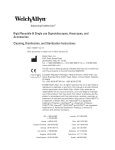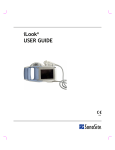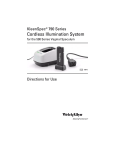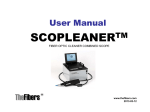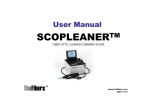Download User Manual - Welch Allyn
Transcript
Thank you for purchasing the Welch Allyn RL-150™ Rhinolaryngoscope. The operating and maintenance instructions found in this manual should be followed to ensure many years of accurate and reliable service. Please read these instructions thoroughly before attempting to use your new RL-150 Rhinolaryngoscope. Warning The user of the RL-150 Rhinolaryngoscope should be thoroughly trained in the medical procedures appropriate to the equipment. Furthermore, time should be taken to read and understand these instructions before performing any procedures. Failure to do so may result in injury to the patient and/or damage to the instrument. While this manual describes the recommended protocol for inspecting and operating the equipment, it does not outline procedure techniques. Only physicians trained and versed in the procedure of nasopharynlaryngoscopy should use this equipment. Table of Contents Specifications............................................................................................1 Components .............................................................................................1 Nomenclature ...........................................................................................2 Prior to Initial Use ...................................................................................3 System Set Up ..........................................................................................3 System Inspection ....................................................................................4 Operation .................................................................................................6 Cleaning....................................................................................................7 Disinfection ............................................................................................10 Sterilization and Aeration ......................................................................12 Storage ....................................................................................................13 Service ....................................................................................................13 Specifications Angle of View .............................75° Depth of Field....................3-50 mm Diopter....................+2 to -8 diopter Tip Deflection Up....................................130° Down...............................130° Distal Rigid Portion Diameter ....................3.4 mm Insertion Tube Diameter .....3.5 mm Insertion Tube Working Length ...........30 cm Total Length .........................53.5 cm Components #65050 RL-150 Rhinolaryngoscope #65015 LX-150 Adaptor Welch Allyn #65008 Eyepiece Cap #65012 ETO Vent Cap RL-100 LENS CLEANER #65007 Lens Cleaner 1 Nomenclature RL-150 Rhinolaryngoscope Diopter Adjustment Ring Angulation Lever Umbilical Cord LX-150 Light Source Power Switch Air Switch Illumination Control Water Bottle Bracket Endoscope Connector Port Insertion Tube Light Guides Air Output Connector ETO Vent Connector Objective Lens Lamp Access Door Distal Tip Bending Section Bottom View Light Guide Terminal 2 Prior to Initial Use Before set up and inspection of the equipment, check all components received against the list of components (see Components section, pg. 1) to verify complete set. If parts are missing, please notify Welch Allyn. Review the Nomenclature, Set Up, Operation and Cleaning/Disinfection sections to become familiar with the equipment. Specifically Inspect: Rhinolaryngoscope Insertion Tube—For tears, cuts, dents, bubbles, bumps Control Section—Test angulation lever/bending section deflection to assure smooth articulation Light Source Cabinet—For any dents, scratches or other surface abnormalities System Set Up Rhinolaryngoscope The No. 65015 adaptor is coupled to your RL-150 Rhinolaryngoscope endoscope connector terminal when shipped from Welch Allyn. [In the event that the adaptor should become uncoupled, Steps 1-2 (below) should be undertaken. Otherwise, proceed to Step 3.] 1. Place the No. 65015 adaptor over the light guide terminal. 2. Thread the adaptor on until snug against endoscope connector terminal. Endoscope Connector Terminal RL-150 Umbilical Cord LX-150 Light Source Adaptor 65015 Endoscope Connector Port 3. Insert the male end of the adaptor into the Light Source endoscope connector port. Push until the ball detent in the light source “clicks” into place to ensure a secure fit. 3 System Set Up (continued) Light Source (See Light Source Manual for complete instructions.) 1. Plug power cord into the receptacle on the back of the cabinet. 2. Plug the remaining end into a properly grounded, hospital-grade AC outlet. 3. Activate power and air switches to verify functionality of the lamp and pump. NOTE: The air pump that is built in to some light boxes is not used for Rhinolaryngoscopy. System Inspection The following steps (in addition to leak testing, cleaning and disinfection) should be repeated prior to every procedure to verify that the system is working. If any problem is encountered, immediately contact Welch Allyn Customer Service for assistance. Insertion Tube Check the entire surface of the insertion tube for abnormalities such as dents, wrinkles, or cuts. Any indentation in a flexible shaft of the endoscope can cause damage to the internal mechanisms. CAUTION: To avoid further damage to the endoscope or the possibility of malfunction during a procedure, do not use any instrument with outward signs of damage. NOTE: The distal end of the fiberscope must be protected against damage from impact. Never apply excessive force by twisting or severely bending the insertion tube or bending section of the instrument. 4 System Inspection (continued) Inspection of Light Guides and Optics 1. With the light source lamp on, hold distal tip approximately 40 mm from any printed surface. Verify light is being emitted from light guides. 2. Hold eyepiece to your eye and rotate diopter ring until print is in focus. Verify focus from 10-40 mm from surface. Inspection of Umbilical Cord 1. Check the umbilical cord for cracks, dents, crushed and twisted areas. 2. Verify that the endoscope connector terminal’s light guide terminal fitting is tight and does not move when light pressure is applied. NOTE: Instrument should be cleaned and disinfected or sterilized prior to every use. (Follow steps starting on pages 7 and 10.) Inspection of Light Source 1. Activate “power” switch. This will start the lamp and cooling fan. CAUTION: Do not look directly into the endoscope connector port when activating the light source. 2. The output of the light source is controlled by the illumination intensity control. Clockwise rotation will increase illumination output. Counterclockwise will decrease illumination. NOTE: If your light source has an air pump built in, the air pump is not used for Rhinopharynlaryngoscopy. WARNING: The risk of thermal injury exists whenever fiber optic instruments are used with high intensity light sources. The risk of injury is greatest: (A) During close stationary observation and/or prolonged close contact with mucosa. (B) When the fiberscope is advanced slowly through a narrow lumen. Close stationary viewing should be avoided and the level of illumination should be limited to the level necessary for adequate visualization. 5 Operation Procedure The methods and techniques of rhinopharynlaryngoscopy are well-defined and documented. Endoscopy training seminars and programs are also in existence. No attempt is made in this manual to outline the medical procedure or techniques of rhinopharynlaryngoscopy. The physician should always take care to understand the clinical background of each patient and the contraindications of the procedure. Preparation Before Insertion Note: The endoscope should be properly cleaned and disinfected or sterilized prior to the first use and all subsequent uses. Only by adhering strictly to the steps outlined elsewhere in this manual can the user be assured of the effectiveness of the processes. 1. Gently clean the objective lens with a cotton-tip applicator moistened with alcohol. 2. Gently wipe the insertion tube with gauze dampened with clean water. 3. The individual user should adjust the diopter adjustment ring to make sure that a clear view can be obtained. No further adjustment should be necessary during a procedure. 4. If desired, apply a water-soluble lubricant to the insertion tube. The objective lens must be kept free of the lubricant which would obstruct your view. NOTE: Do not use lubricants that are petroleum based as these will deteriorate the rubber covering the bending section. Insertion and Operation 1. Always insert the instrument slowly under direct vision. 2. Once lumen is visible, adjust the light intensity control on the light source to desired setting. Note: The distal tip of the rhinolaryngoscope may become warm if in continuous operation with the illumination set too high; this can damage the mucosa. Use the lowest light setting possible. 3. Tip deflection must be performed under direct observation. Deflect the bending section gently using minimal force. 4. When withdrawing the instrument, pull back slowly under direct observation. Do not remove the instrument “blindly”. 6 Cleaning Endoscopic instruments should be cleaned immediately after each use. Endoscopes are delicate and will degrade if not cleaned promptly, due to the effects of blood, mucous, etc. The steps outlined on the following pages have been tested and verified to have no damaging effects. Therefore, these procedures should be adhered to. Supplies Needed For Cleaning Large basin of water Disposable gloves Leakage tester 65009 T ES D GE R AN T Cleaning solution (soap solution) 0.2 0.1 0.3 0 0.4 Gauze pads Soft scrub brush Immediately After Procedure… 1. Immediately after removing the instrument from the patient, gently wipe all blood, mucous and debris from the insertion tube with a gauze pad moistened in clean water. 2. Turn off the “power” switch on the light source. 3. Disconnect endoscope from light source by grasping endoscope connector terminal/adaptor and pulling back gently. 7 Cleaning (continued) Perform Leak Test Procedure The leakage test allows for a simple two stage test of the water tight integrity of the instrument. Air pressure is introduced into the interior of the instrument by means of a hand pump. The instrument is then checked for pressure decay via a gauge and then visually. T T ES D 0.2 0.1 GE R AN Green Zone 0.3 Red Zone Air Bladder Scope Connector 0 0.4 Pressure Release Hand Bulb Leakage Tester Stage-One Test T ES D 0.2 0.1 0.3 0 0.4 8 G ER AN T BEFORE IMMERSION, the instrument should be tested for any major loss of integrity in its watertight construction (example: major tear in the bending section). 1. Secure the Leakage Tester to the ETO vent connector on the instrument’s endoscope connector terminal. The Leakage Tester connector and the ETO vent connector MUST be dry before securing. Proper connection will require alignment of the air vent pin and clockwise rotation. 2. Turn the gauge faceplate to “zero” on the pressure indicator. Cleaning (continued) T GE R AN 3. Pressurize the scope by pumping the hand bulb T D ES until the indicator on the gauge is in the green 0.2 0.3 zone. DO NOT pressurize into the red zone; it 0.1 0.4 may cause serious damage to the scope. 0 4. Observe the gauge pressure to determine if the indicator remains in the green zone. If the indicator drops from the green zone rapidly, a major leak may be indicated. NOTE: Be certain that the pressure release valve on the handle of the leakage tester has been tightened. DO NOT IMMERSE the entire instrument if the gauge indicator does not remain in the green zone. Instead, contact Welch Allyn Customer Service. Stage-Two Test T ES D 0.2 0.1 GE R AN T After determining the absence of any major leak in stage-one testing, the instrument may be immersed in clean water to test for loss of integrity in the watertight construction. 1. With the leakage tester securely attached to the instrument and the scope pressurized with the gauge indicator in the green zone, the entire scope may be immersed in clean water. 0.3 0 0.4 NOTE: Only the leakage tester connector and a small portion of its tubing should be immersed. Never immerse the entire leakage tester. T ES D 0.2 0.1 G ER AN T 2. Observe the instrument carefully. A few bubbles may initially rise from recessed areas of the scope. This is normal. If a continuous stream of bubbles is observed from the same spot, a leak is indicated. Immediately remove the scope from the water. DO NOT use the scope. Contact Welch Allyn Customer Service immediately. 0.3 0 0.4 3. After removing the instrument from water, release the air pressure by opening the pressure release valve on the handle of the leakage tester. After the gauge indicates “zero”, disconnect the leakage tester from the scope. 9 Cleaning (continued) NOTE: Never connect or disconnect the leakage tester under water. This will allow water into the instrument and leakage tester. 4. If leakage was discovered during stage two, thoroughly dry the instrument and contact Welch Allyn Customer Service. 5. If no leakage was discovered during stage two, you may proceed with cleaning and disinfection of the instrument as outlined in the following pages. Cleaning Procedure 1. Prepare a basin with warm water and a mild detergent. Immerse the instrument in the solution. 2. Thoroughly (but gently) wash the entire outer surface of the instrument with a soft brush or guaze pad. Remove the instrument from the basin. NOTE: Do not squeeze or severely bend the insertion tube. Do not use any abrasive materials. Be careful to avoid damage to the ocular and distal lenses. 3. Place in basin of clean water. Thoroughly rinse the outside of the instrument. 4. Gently dry all external surfaces of the fiberscope with soft gauze or a towel. DO NOT put tension on the insertion tube of the endoscope while drying since the outer cover of the bending section may be excessively stretched. Dry the ocular lens with a cotton-tip swab. Disinfection Before any attempt is made to disinfect the fiberscope, the complete cleaning procedure, as previously described in this manual, must be completed. Complete Immersion Before complete immersion in any disinfecting solution, the instrument should be LEAK TESTED as described elsewhere in this manual. Before immersion, the Red ETO vent cap MUST be removed. 1. Immerse the instrument in a basin filled with a compatible disinfection solution. WARNING: Using a disinfectant other than those tested for compatibility with the instrument may result in severe damage to the instrument. Contact Welch Allyn Customer Service with any questions regarding solution compatibility. 10 Disinfection (continued) 2. The instrument should remain in contact with the disinfecting solution for the time period recommended by the manufacturer of the solution and accepted by the user as appropriate. 3. After the instrument has been in contact with the disinfecting solution for an appropriate time, remove the instrument from the solution. 4. Place in a basin filled with clean water to rinse all residual disinfecting solution from the instrument. Remove instrument from water. 5. Gently dry all external surfaces of the instrument with soft gauze or towel. Do not put tension on the insertion tube while drying since the outer cover of the bending section may be excessively stretched. Dry the ocular lens with a cotton-tip swab. Using the Disinfection Tray 1. Fill the clear tube of the disinfection tray with disinfectant up to the black indicator dot. 2. Slide insertion tube into the disinfection solution and position the instrument’s control section securely in the space provided on the disinfection center. 3. Carefully wind the umbilical cord and place next to the tray as illustrated. 4. After soaking for the disinfection solution manufacturer’s recommended time, remove the instrument from disinfection tray. 5. Immerse the insertion tube in clean water to rinse. 6. Remove instrument from water and dry surfaces of the instrument thoroughly. 7. Hang scope with insertion tube straight to dry. 11 Disinfection (continued) Disinfecting Solutions Specific reference to brand names is not an endorsement of their efficacy as a disinfecting solution. Tests have shown these solutions to be compatible with the RL-150 Rhinolaryngoscope, providing the manufacturer’s directions are followed. Solution Brand Name Source Usage Glutaraldehyde Cidex (14 Day) (2%) J&J Medical Follow manufacturer’s instructions Glutaraldehyde Wavicide-01 (2%) Wave Energy Systems Follow manufacturer’s instructions Glutaraldehyde Metricide (14 Day) (2%) Metrex Research Corp. Follow manufacturer’s instructions Sterilization and Aeration Before any attempt is made to sterilize the fiberscope, the complete cleaning procedure as described elsewhere in this manual must be completed. Only the user can assure that sterilization techniques, like those described here, will accomplish the desired clinical effect. IMPORTANT WARNING: Never place the fiberscope in a steam autoclave! Never subject the fiberscope to ultrasonic cleaning methods! Ethylene Oxide (ETO) Gas Sterilization can be performed on the RL-150 Rhinolaryngoscope provided the following special instructions, which differ from other endoscopes, are followed to ensure proper performance of the instrument. 1. The endoscope must first have been properly cleaned and thoroughly dried according to the instructions in this manual. a) The Red ETO Gas Sterilization Venting Cap MUST be on securely. b) Temperature must not exceed 55°C (131°F). c) Pressure must not exceed 24 PSI. d) Humidity must not exceed 50%. e) Sterilization procedure must not exceed 4 hours. 12 Sterilization And Aeration (continued) 2. Following ETO Gas Sterilization, aeration time of 72 hours at room temperature is required. 3. Aeration Chamber: To shorten the aeration time to 12 hours, an aeration chamber may be used, provided the temperature does not exceed 55°C (131°F). NOTE: Prior to placing the RL-150 Rhinolaryngoscope in an aeration chamber, the Red ETO Gas Sterilization Vent Cap MUST be on securely. Cold Sterilization For those situations where Ethylene Oxide (ETO) Gas Sterilization capability is not available, Welch Allyn endoscopes have been designed to withstand immersion in Glutaraldehyde solution for a maximum of 10 hours to achieve “cold sterilization”. Never fully immerse the instrument without first conducting the leakage test procedure, as described elsewhere in this manual, to verify the watertight integrity of the scope. WARNING: Never exceed 10-hour maximum immersion. After 10-hour immersion, the instrument must be thoroughly rinsed to remove all residual Glutaraldehyde solution. After being thoroughly rinsed, the instrument must be allowed to “breathe”, balancing internal and external humidity, by attaching the Red ETO Venting Cap. Storage Thoroughly dry the instrument and accessories. Place in the wall hanger. 1. During storage, the insertion tube of the scope and the light guide should be kept as straight as possible. 2. The storage area should be dry and airy. Avoid high humidity, high temperature and areas exposed to direct sunlight. 3. The Red ETO Venting Cap should be placed on the scope to allow the scope to “breathe”, balancing internal and external humidity, while it is in storage. Service Customer Service Telephone Assistance: (315) 685-4560 For repairs on the RL-150 Rhinolaryngoscope, ship to: Welch Allyn Technical Service 4341 State Street Road Skaneateles, NY 13153 13 4341 State Street Road Skaneateles Falls, NY 13153 315-685-4560 800-535-6663 Printed in U.S.A. Part No. 650033 Rev. C


















